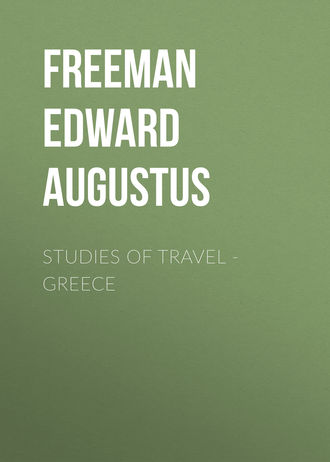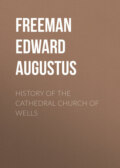
Freeman Edward Augustus
Studies of Travel - Greece
Sounion
One more excursion, this time not on the Attic soil, but on the Attic sea, must be added to the Eleusinian and the Marathônian pilgrimage, even by those who cannot undertake to follow the keen guidance of Colonel Leake into every corner of the Attic δῆμοι. The survey of the Attic land may well be ended at the point where, in geographical accuracy, it ought, by those at least who approach by way of Syra, to have begun. But to one thus drawing nigh for the first time, Sounion is at most the beacon which points to Athens; it may even be that, if he chances to draw nigh on a dim and cloudy morning, he may fail to distinguish the marbled steep of Sounion among the other lofty points over which his eye wanders. He expects, it may well be, that the height and the temple will front him boldly as the first point of Attic ground to catch his eye. He may not thoroughly take in the fact that the promontory lies in a manner round a corner. Unless he has studied his map very carefully, he may draw near under the belief that the Attic peninsula ends in a point, in the same way in which the three southern peninsulas of Peloponnêsos, that of Tainaros above all, certainly do. Pausanias indeed begins his picture, not only of Attica, but of all Greece, with the “height of Sounion, stretching forth from the Attic land and the mainland of Hellas towards the Kyklades and the Ægæan sea.” Yet it is certain that some who have approached the mainland of Hellas from the Kyklades have not been lucky enough to catch a sight of Athênê on the promontory as a harbinger of Athênê on the inland rock. Even he who is more favoured cannot, at that moment, stop to study the arrangement of the columns which still keep their ancient whiteness. Nor will he, as he sails by, find out that there too the rival of Athênê was not wholly ousted, that the sea-god kept at Sounion a secondary place, at least as important as that which he kept at Eleusis alongside of Dêmêtêr and her Child.
A voyage to Sounion forms then a necessary part of even a short sojourn in Athens and Attica. He who is careful about mines, old or new, might prefer a land journey which should combine Sounion with Laureion. Otherwise it may be better to put oneself under the guardianship of the lord of the dolphins, to whom men prayed on Sounion (ὦ χρυσοτρίαιν’, ὦ δελφίνων μεδέων Σουνιάρατε), and to trust to his golden trident to clear the way. That way leads by several striking points of coast, each cape having, as a rule, an island placed before it as a kind of outpost. Such above all is Zôstêr, where the narrow isthmus, as Dean Blakesley hints, tied the promontory to the shore, but where pious etymologers at a later time saw the spot where Lêtô loosed her girdle. Such an etymology is much of a piece with many popular etymologies in our own land. From the hill of Battle we look out on Telham, so called, says the local legend, because the advancing Norman there told his army. Not far off flows one of the “cold becks” which have given their names to so many spots from Normandy to Scotland. Here it is said to mark the spot where the Duke called back his flying men. The derivation of Zôstêr from Lêtô’s zone is a guess essentially of the same kind as these; yet there is a difference between them which is not uninstructive in comparing the history of the Greek and the English language. In the English derivations the real meaning is absolutely forgotten; wholly wrong words, having merely an accidental likeness in sound, are pressed into the service. In one of the two cases the word thus misapplied has itself in that meaning become obsolete. It is not unlikely that a new legend may arise, and that Telham, instead of the spot where William told— that is, numbered — his army, may become the spot where he told them to do this or that. But Greek had not, in the days at least when the Zôstêr legend was invented, been so utterly broken up as that men were likely to go off to an altogether wrong root. The tale kept within the prescribed range of tying or untying something or other; and Lêtô, Artemis, and Apollôn gained a fresh seat of worship through the etymological guess. But Zôstêr has its place in history as well as in legend. The Persians, after Salamis, took, so says Herodotus, the three small peaks which form the peninsula for Athenian ships, and fled all the more till they found out their mistake. One sceptical historian suggests that it must have been a moonlit night. But, after all, may not this story be less legendary than that of Lêtô, only so far as that real actors are brought in? That the Persians took the rocks of Zôstêr for ships and fled all the more is the kind of mocking saying which was likely to be said at the time, whether true or false. And, even if it was a mere mocking saying, it might well have passed into serious belief before Herodotus, a four-years-old child at the time, had grown into an inquiring historian. After all, the story belongs to a class. There are the thistles which the armies took for spears after the fight of Montl’hery. There are the Welshwomen in the red cloaks, whom the French at Fishguard took for regular soldiers coming to the help of the valiant militia of Pembrokeshire. Did all these things happen, or are they all mere sayings which have found their way into history? Let comparative mythologists argue the point.
But we are followed by etymologies along the whole coast. Every one who has ever looked at the map knows the long island, immediately east of the southern point of Attica, whose name fluctuates between the mere description Makris and the more attractive name of Helenê. How came Helen hither? We may be sure, with all deference to Strabo, that this is not the Kranaê of the third book of the Iliad; that was far away by the Lakonian shore, and the Homeric reference was commemorated by a temple of Aphroditê with an unseemly surname. So Pausanias tells us, though he does not explain what brought Helen to the long island off Sounion. We will not hint that according to one Homeric story (see Odyssey iii. 278) she must have been, if not on the island, at least near it, in better company and at a later and better part of her story, than that in which Strabo would bring her into these parts. But on Attic soil or on Attic waters we must learn to feel an Attic patriotism, and, so minded, we can give her a chance from another quarter. We must not forget that Helen has her independent place in Attic as well as in Peloponnesian legend. She was carried off by Thêseus as well as by Paris. She was known at Aphidna, at Dekeleia, and at Rhamnous; and it would be only a fair freak of etymological invention to give her an island off the Attic as well as off the Lakonian coast.
But with Helen in this way to guard the eastern side of the southern extremity of the Attic land, it is a little disappointing when we find the real origin of the name of the much smaller island which guards its western side. There lies the isle of Patroklos. Helen and Patroklos seem well matched; and a charm seems to be broken when we find that the island takes its name, not from the Homeric antitype of Jonathan, but from the Admiral of Ptolemy Philadelphos, who there dug a trench and threw up a wall when he came to help Athens against Antigonos Gonatas. Such a fall from poetry to prose, from legend to history, is really sad. Yet we may draw some small comfort. Everything is a gain which reminds us that the history of Athens did not end with the war of Chairôneia or with the war of Lamia, but that Ptolemy and Antigonos, and men later by ages on ages than Ptolemy and Antigonos, had something to do with fixing her destinies.
The island of Patroklos is the last of the series of capes and islands between Peiraieus and Sounion. All have lost their names, unless any one takes Phaura and Phleua to be forms of the same name. All the rest have descriptive names ending in νησί — the diminutive form, which, according to rule in modern Greek, has supplanted the older νῆσος — just as along our own shores they might end in holm or ey. We turn round the last point, and now —
Σούνιον ἱρὸν ἀφικόμεθ’, ἄκρον Ἀθηνῶν.
A sceptical thought will flash across the mind. Ought we not to read Ἀθήνης for Ἀθηνῶν? But if we stifle the thought, we have again another witness to the way in which all Attica had even in Homeric times already become Athens. There is the little bay fenced in by the height, crowned by the white columns, which gives the cape its modern, its Italian, name. The name is well applied; Sounion is before all things the Cape of the Columns. The pure white which their marble still keeps is striking to the eye which has been for some time accustomed to the yellowish brownish hue of the standing columns of Athens. We say the standing columns, because those columns of the Parthenôn which have been thrown down are as white as those on Sounion. But for this last fact, it would be easy to account for the difference in the hue of the columns by the difference between the pure sea-air of Sounion and the air of an akropolis rising above a great city. Only here comes in the difficulty which is suggested by the whiteness of the fallen columns at Athens. Either the discolouring of the columns which are still standing has happened since Morosini’s siege, or else the columns that are overthrown have regained their whiteness since their fall. We do not pretend to explain the difficulty; we only state it. All that we are concerned with is the striking effect of the white marble of the columns on Sounion as contrasted either with the discoloured columns of the Parthenôn, or with the primitive columns of rougher stone which were covered with some kind of plaster from the beginning. The actual material of the columns of Sounion is something intermediate between the two. It is marble, but marble from the neighbouring hills, much less fine than the Pentelic marble of the Parthenôn. Another point at once strikes the eye. Thirteen architectural objects stand up, but it is soon seen that only twelve are of the usual shape of columns. What is the thirteenth? It looks like a square pier, such as we should expect to find inside a basilica at Lucca, but not outside a temple at Sounion. The appearance is puzzling until we actually reach the site of the temple and there carefully spell out the ground plan. But before we do this two other remains have to be studied. Sounion, besides being a holy place, was also a fortress. When the news of the overthrow at Syracuse came to Athens, when every means was used to prop up the tottering commonwealth, one means of defence that was taken was the fortification of Sounion. This was done with the special object of supplying a defence to the corn ships which brought in the foreign food that Athens needed more than ever when the Peloponnesians were at Dekeleia. A large part of the wall which cut off the promontory is still to be traced, a wall of the best Hellenic masonry, strengthened by square towers at intervals. Within this military circuit again we come to the remains of the Propylaia, the entrance, as at Eleusis and at Athens itself, to the immediate sacred precinct. But the summit of all, crowning the promontory and immediately overlooking the sea, is the temple itself. And when we come carefully to study its plan, we see the meaning of the anomalous square object which seemed so puzzling from below. The temple was one in antis, and the square object is the end of one of the walls of the cella. The fellow to it may be traced, though it does not rise high enough to make a feature in the general view. One of the columns ranging with the antæ, two on the northern side towards the land and nine on the southern or seaside, are still standing with their architraves; but the eastern and western fronts, with their columns and pediments, have perished.
It is indeed a spot to stand and gaze, though now with quite other and happier feelings than those which Byron put into the mouth of his imaginary Greek poet. The impulse is to gaze on the sea and the islands, the realm of Athens, the realm which her fortress on Sounion was to guard. But it is well to look landward also, and a short walk from the temple will show that Athênê was not the only power that was worshipped on Sounion. That the sea-god, lord of the Sounion dolphins, was worshipped there is plain from Aristophanes. The jokes in the Birds, where the god is addressed, give us another title of the sea-god. Poseidôn at Sounion, like Zeus at Dodônê, was prayed to as Pelasgian. The comic poet, when he had once got into Nephelokokkygia, does not scruple to change the epithets of the deity into “hawky” and “storky.” We might be sure from this that Colonel Leake was misled in fancying that Poseidôn had nothing more than a mere altar on Sounion. We come down from the temple of Athênê, we pass the Propylaia; we pass the ruins of the wall; we reach the little isthmus — for the site of the temple is peninsular — and on a lower height we find remains, not enough to enable us to make out the plan of any building, but enough to show that a building of some importance must have stood there. Surely here we have the site of the temple of the god who was prayed to on Sounion. Poseidôn is here, as well as at Corinth, at home on his isthmus.
Ὦ Σουνιέρακε χαῖρ’ ἄναξ Πελαργικέ,
The men of Sounion are the subject of an allusion of the poet Anaxandridês, quoted by Athênaios, which at first sight is not very clear: —
πολλοὶ δὲ νῦν μέν εἰσιν οὐκ ἐλεύθεροι, εἰς αὔριον δὲ Σουνιεῖς, εἶτ’ εἰς τρίτην ἀγορᾷ κέκρηνται.
Some say that this refers to their prosperity as living near the mines of Laureion. The words in themselves would seem rather to point to a class intermediate between the slave and the full citizen. But how could there be such in any part of Attica after the union of the Attic towns? Of their modern successors, a few might be seen near the mouth of a cave by the sea, some contemplating the strangers, others following the useful occupation of Nausikaa. The whole scene — the little bay, with its beach beside the blue waters; the hills behind, with their white columns against the sky; the cave, suggesting endless Homeric remembrances of nymphs and sea-gods — even the homely work going on by the shore — all seems in harmony; all seems to carry us back to the days when the powers which had striven for Athens seem to have agreed to hold Sounion as a joint possession.
Olympia and its Church
Olympia, when the German diggers have fled before the heat of a Greek summer, when they have left all the statues and other beautiful things that they have found sealed up against all men, Greek and barbarian, may seem to be, even literally, Olympia with the spring taken out of its year. But Olympia can, for all general historical purposes, be Olympia without them; some minds may not greatly regret their absence. To some minds galleries, museums, collections of all kinds, are simply wearisome. The weariness is one which may be well endured for the sake of the knowledge which may be gained through it; still the contemplation of objects in rows and cases, catalogued and numbered, is weariness compared with the pure pleasure of contemplating the same objects, each in its right place, each forming part of the whole of which it was meant to form part. Better one statue without a nose, in the place where the sculptor first put it than ten statues with noses set up apart from their context in any collection in Athens, Rome, or London. No blame of course attaches to the diggers at Olympia. The objects which they found were not in their places, and could not be kept in their places. They can only be kept in a museum; and to our minds that museum should not only not be at Berlin or London — an evil of which Greek law forbids all danger — but it should be at Olympia and not at Athens. The little collection at Eleusis is in its right place; it is at Eleusis; so it should be with the greater collection at Olympia. But the feeling that a museum, with all that it teaches, is in itself a bore, that its lessons are painful lessons, somewhat tempers the traveller’s disappointment at finding that the relics are all shut up, and that the key is somewhere in Germany. For the buildings themselves are not carried away; they can be studied without let or hindrance, and perhaps with even a deeper feeling of thankfulness to those whose untiring zeal and energy have uncovered them. And the plain of Altis, the stream of Alpheios, the hill of Kronos, the mightier Arkadian mountains, are there in any case. And they, with the immortal remembrances of the spot, are the true Olympia.
From the port of Katakolon to the town of Pyrgos there is a road, and that road goes on further to Olympia itself. The venerable spot can therefore be reached in a carriage. The question might, however, be raised whether a carriage journey over such a road as that between Pyrgos and Olympia — a journey moreover modified by occasional spaces where it is better to go on foot — is not at least as tiring as the ride from Mykênê to Corinth. But, as the traveller goes along from Pyrgos to Olympia, especially as he nears the immediate object of his pilgrimage, he can hardly fail to draw the comparison between the nakedness of Attica and the land through which he passes, rich with trees and with cultivation, the bleak mountains replaced by lower hills which are often green with verdure, with villages scattered thick among them, the scenery in many places coming nearer to that of the hillier parts of England than might have seemed possible in Greece. It is only here and there, when the eye catches some of the more distant points of the landscape, especially when the vast heights of Arkadia come in view, that it is brought strongly home to his mind that it is through Hellas that he is journeying. At last, however, he reaches the spot which was the religious centre of Hellas, and there the Arkadian heights, soaring over the lower hills which surround the Olympian plain itself, fully remind him where he is. Here is the spot where, more than in any other, every Greek was reminded that, however war and policy might divide them, he was still a sharer with every other Greek in a heritage of language, religion, and general culture in which the barbarian had no share, where the Greek from the Spanish Zakynthos and the Greek from the Tauric Chersonêsos could feel themselves, if not countrymen, at least brethren, before the temple of the common Father of Gods and men. Here were the victories won which were recorded in the odes of Pindar; here, we would fain believe, Herodotus recited his history to assembled Greece; here the Macedonian King had to prove his descent from an Argeian stock before he could be admitted as a worthy competitor of Hellenic freemen; here Alkibiadês made that display of lavish splendour which at least proved that the resources of Athens were not worn out. And as we read inscription after inscription recording the name of Elis and her citizens, our thoughts go back to the never-forgotten claims of the true people of the land. We remember how Pisa — the name may almost seem strange in this, its more ancient seat — deemed herself to be the lawful President of the Olympian feast by an older right than could belong to the intruders from Aitolia. And we think too of that one day in later times when the arms of Thebes won back for them their ancient right for one passing moment. All this might press on the mind as we look on the plain by Alpheios, and people it in imagination with competitors, spectators, worshippers, the very realm and trysting-place of the scattered Hellenic nation. All this we might call up, even if no actual monument of those days were there to remind us of them. Yet it is something to think of all this beside the uncovered foundations of the great Pan-hellenic temple; and it is something more still to trace out all that Olympia suggests in the presence of remains which tell us of the times when the Pan-hellenic temple and its festival had passed away.
The foundations of four principal buildings have been brought to light by the German diggings. Two of them belong to the days alike of pagan worship and of Hellenic freedom. There is the lesser, the older temple, the temple of Hêrê, in the spreading capitals of its massive Doric columns — capitals, be it remembered, now lying shivered around their feet — carrying us back to the solemn and solid style of Poseidônia and of Corinth. Side by side with this venerable fragment we find inscriptions of Roman date, bearing witness to the unity of history, and showing how Olympia still remained holy after captive Greece had led captive her conquerors. Hard by stands the great central monument of all, the temple of Zeus itself, not a column of its vast ranges standing perfect, but with, frequently enough, capitals of less antique form than those of the lesser temple, to show the date and style and character of the building which held the greatest work of Pheidias. But it is not only the days of Pheidias, the days of free Greece, the days of Athenian, Spartan, and Theban rivalry, which are represented in their remains with that memorable precinct. Two periods of the history of Greece and the world have still to be represented. There is that vast semicircle of Roman brickwork, looking like the apse of a vast basilica, but which is in truth the exedra of Hêrôdês Atticus; for the bountiful man of Marathôn extended his bounty to the shrine of the common gods of Hellas as well as to the temples, the theatres, and all the public works of his own city. But the cycle is not yet complete; there is one age more to be represented, one phase more of the history of man to furnish its contribution to the architectural remains of Olympia. And that age, that phase, has, from one point of view at least, the highest claims on us of all. We take our chance of being set down as irreclaimable barbarians when we say that, after all, the building of highest interest of which the remains are now to be seen at Olympia is the admirable basilican church which occupies the site of the temple of Hippodameia. Enough remains to enable us to make out nearly the whole of its arrangements. It marks a very narrow view of things, a strange imprisonment of thought within a few arbitrarily chosen centuries when we see not a few who reverence every stone of the great and the little temple, even, it may be, every brick of the exedra of Hêrôdês, but who seem to turn up their noses at a monument at least as historical as any of them. No doubt the special interest of this particular building is largely due to the place where it is found. It is because it is found in the Altis of Olympia, because it is built on the site of one of the ancient temples of Olympia, because its materials have been supplied by that and by others of those temples, that the church which now stands as a ruin alongside of them has much of its special charm. To take the lowest view, it is a memorial of the greatest revolution of the whole course of history, the revolution which installed the worship of Christ and the Panagia on the site of the shrines of Zeus and Hêrê and Hippodameia. The classical purist cannot get rid either of the general history of mankind or of the more enlarged view of the history of art merely by shutting his eyes to both of them. The basilica is there; it is a fact; it is also a fact that those who placed it there had a special motive in placing it there — that of specially marking the triumph of the new faith by setting up its altars on the site of the fallen altars of heathendom. And it is a fact also that, however mere classical pedantry may despise the style in which that basilica was reared, it is simply pedantry that will despise it. The style, constructively perfect in itself, contained in itself the germ of all that was to come after. We cannot reach Köln and Westminster, except by the necessary stages of Spalato and Olympia.
We may for a moment sympathize with the pedants as we read the inscription of Jovianus at Corfu. Jovianus destroyed, and he put very little in the place of that which he destroyed. We treasure his work and his boast as pieces of history; but we must allow that art, as such, has no reason to thank him. But the case is quite different with the basilica of Olympia. Its architect may take his place alongside of those who did the bidding of Diocletian and Theodoric. He destroyed indeed, but he destroyed only to put to new uses. The shrine of the new faith was reared out of the very stones of the shrine of the old. The columns which, in a past state of things, had known only how to bear the dead weight of the entablature, were now taught to lift up the arch, as a living thing rising from their own substance. Enough is left of the basilica of Olympia to show that it might have held its own even among the basilicas of Ravenna. But at Olympia the name of Ravenna seems to awake no echo, to carry with it no meaning. In all accounts that we have seen the building is said to be Byzantine. That perhaps simply means that it is Christian and not heathen. Byzantine, in any architectural sense, the church assuredly is not. It is essentially basilican, without any Byzantine features. Nor can the date be late enough to be called Byzantine in any political sense. We may talk about Byzantine after the final separation of the Empires in 800; before that time the word leads to confusion. One cannot conceive this church to be later than Justinian’s time; it may well be earlier. When could such a building have been so utterly overthrown and swallowed up? We can think of no time so likely as the Slavonic and Avar inroads of Justinian’s own day and of the days of his immediate successors.
The church itself is a not very large basilica of the purest and simplest type. There is no dome, no approach to Byzantine arrangement, not even the chalkidikê or transept. Two arcades supported by the smaller columns of the former building, showing Ionic capitals of two types, led to an apse of which the arch of triumph has unluckily together vanished. But of the well-wrought cancelli, carrying the mind across the sea to St. Clement’s, a large part still remains. The apse has its windows divided by what at first sight seem to be coupled columns — the type which ranges from St. Constantia to the Moissac cloister — but which really form a single block within and without. The walls are of brick; several of the windows are preserved, and in their jambs we see long stones set upright, just as in the primitive work both of England and Ireland. Everywhere we find these witnesses to the universality of the earliest form of Christian architecture. The pavement contains many inscribed stones of various dates. Some are Pagan, recording votes of the city of Elis in the days of the early Emperors; some are Christian, as that which records the zeal of a certain pious reader ἀναγνωστής towards the making of the pavement itself. To the west of the nave is a range of Ionic columns forming the portico, but their arches or entablature has perished. But to the south-west is an attached building where alone the arches are preserved. They are set on the Ionic columns with an intervening stilt set crosswise in a most ingenious fashion. The column becomes a mid-wall shaft.
Such a building, on such a site, found in such a case, suggests thoughts which bring all the ages of the world together. The old glory of Olympia passed away; free Elis — whatever we say of free Pisa — no longer gathered the competitors of free Hellas from Massalia to Trapezous to strive in a national solemnity before the national gods of Hellas. But Olympia lived on as long as the Roman masters of Hellas clave to the gods of Rome, and saw the gods of Rome in the gods of Hellas. A day came when the lord of Rome cast away his faith alike in Zeus of Olympia and in Jupiter of the Capitol; a day followed when a later prince forbade either worship, when the games of Olympia ceased as a rite of the forbidden worship, when her temples were forsaken or destroyed or made into materials for new temples of the new creed. Presently barbaric invasions swept away the new temple and the old alike. Zeus was still worshipped on Tainaros; St. Andrew still helped his votaries at Patras; but the temples, pagan and Christian, of the Olympian Altis lay hidden and forgotten, and the hill of Kronos looked down on solitude instead of on the great religious centre of the Hellenic race. Ages after, the zeal of strangers working on Hellenic ground brings to light the ruins of the pagan temples, and with them the ruins of the Christian Church. We rejoice in both discoveries; only let it be remembered that each alike is part of the history of Hellas and of the history of man. We will at least believe that there is no fear that the recovered church of Olympia may share the same fate which the narrowness of classical barbarism decreed for the ducal tower of Athens.







